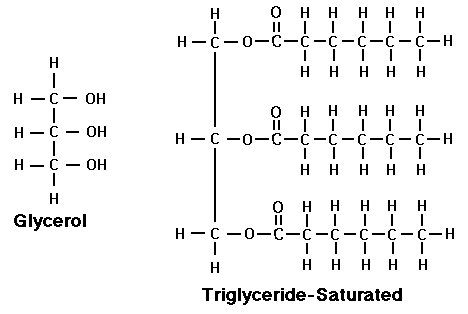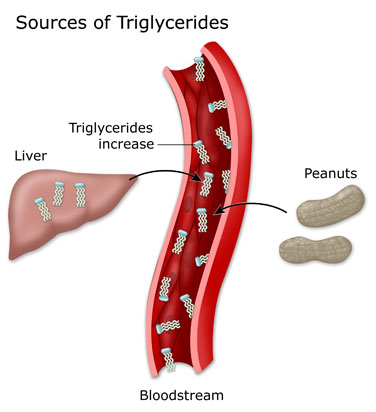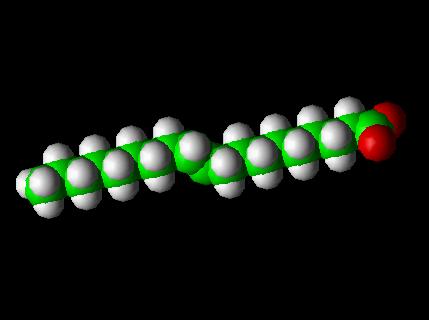The Fat Project
Introduction

Fats. People don't know as much about them as they think they do. Many just say "Fat is bad", or "Fat is good", but they don't know why. For example, can you explain why monounsaturated fats are better than both other unsaturated fats and saturated fats? Or what a Free Fatty Acid (FFA) is? Of course, if you're Mr. De or another member of the science community, then you probably can. But the purpose of this wiki is to explain and explore fats, cholestrol, nutrition, and other related topics to help all of those non-biologists and health-concious people out there to better understand what they eat, and how their diet affects their bodies.
Fats

Fats are essential to the body in order to grow and function. They are found in all living species, namely plants and animals, and therefore in our food. Some of the more well known fats are Saturated, Unsaturated, Monounsaturated, and the Britney Spears equilivant of the fat world - the notorious Trans fat. Of these, monounsaturated fats are the best because they help lower bad cholesterol in the body. Saturated fats and Trans fats both raise cholesterol levels, which can lead to atherosclerosis, heart attacks, and strokes. Unsaturated fats are better for you than saturated and trans fats, but they can still cause you to gain weight. Now lets explore these different kinds of fats, and other terms related to them.
Triglycerides
Triglycerides are the chemical form in which most fats are found in the body. They are composed of a glycerol molecule bonded to three fatty acids (hench the triglyceride). These fatty acids are a long chain of carbons and hydrogens with a carboxyl group on the end. This carboxyl group reacts with the glycerol in a process called dehydration synthesis to bond the fatty acid to the glycerol, producing a water molecule in the process. However, triglycerides are also very low density lipoprotiens, which carry cholesterol throughout the body. They are found in your food, where they add flavor, in your blood plasma, which is the liquid that blood cells, nutrients, and other things flow through in your body, and other places throughout the body. The unused triglycerides that you eat in a normal day are stored in your body's fat cells, and the body can retrieve them at any time when it feels that it needs the energy that is created by burning your fats. Triglycerides also help to keep your body warm. These pictures below show the structure of a triglyceride and what an increase of ingested trigylcerides does in your body.


Omegas
Omegas are essential, unsaturated fatty acids that the body needs to function, but which cannot be created by the body. These fatty acids are crutial for brain function and are a nessicity to the health of the body, because they help you to grow and develop, as well as slowing blood clotting, which prevents heart disease. Therefore, Omegas such as Omega-3 and Omega-6 might lower the chance of getting a heart disease and might also improve your memory. Omegas can be found in food such as fish, fish oil, some marine life, plants, nuts and nut oils. This video provides great information about Omega-3 and why it is beneficial to your body.

FFA (Free Fatty Acid)
Some FFAs, or Free Fatty acids, are made by soluble fibers that ferment in the intentines, since they can not be broken down or digested. They are also created by the breakdown of fat within a cell. These fatty acids are good for the body because they go to the liver and tell it to make less cholestrol. But having too many Free Fatty Acids can be bad because high levels of these acids can decrease the liver's ability to store sugars, create insulin, and in effect cause diabetes.
Unsaturated Fats
Unsaturated Fats are fats that do not have the maximum number of hydrogens possible in their molecular structure, due to at least one double or triple bond between carbon atoms. They are in liquid form at room temperature due to this structure. These fats are better than Saturated fats because they lower LDL cholesterol but in large amounts can also lower the gool cholesterol known as HDL, therefore lowering chances of atherosclerosis, heart attack, and stroke due to high cholesterol. This is because Unsaturated fats both help to get rid of cholesterol that the body produces, and because they come mostly from plants, which have lower levels of cholesterol than fats from animals. Unsaturated fats also assist in the growth of hair and skin. But despite being better than other types of fats, eating excess amounts of unsaturated fats will cause you to gain weight. The diagram below shows the physical differences between saturated and unsaturated fats. When there is a kink in the carbon-hydrogen chain of the fatty acid, it indicates that the triglyceride is a unsaturated fat, since there is a double or triple bonded carbon where 2-4 hydrogens would bond to carbons in a saturated fat, hence the name unsaturated.
Saturated Fats
Saturated Fats have the maximum number of hydrogens bonded to the carbons in their fatty acid chains that is possible. This makes them solids at room temperature. They come mainly from animals, which makes them have a higher cholesterol. This is because your body, and animals' bodies, produce cholesterol in the liver, and also in the cells, so there is cholesterol in animal products. Therefore, these fats raise the amount of cholesterol and LDL, or "bad cholesterol" in the body. This short animated video explains what foods contain saturated and trans fats, and why they they are bad for your and your body
Monounsaturated Fats
Monounsaturated fats are unsaturated fats with only one double bond. The latin word mono means one and mono unsaturated means one unsaturated. Monounsaturated fats are liquid at room temperature, but when cooled slightly, they become solid. Monounsaturated fats are better than a normal saturated or trans fat because they lower LDL levels and raise HDL, or "good cholesterol", levels in the body, but only when consumned in proper amounts. It does this by getting rid of cholesterol that the body forms, which decreases the amount of LDL produced. These fats have a lot of Vitamin E which is good for the body because it helps your immune system stay healthy, and might help prevent cancer. For this reason, it is possible that monounsaturated fats can provide protection against some cancers, such as breast and colon cancer. Monounsaturated fats can be found in olive oil, among other products. This diagram shows a monounsaturated fatty acid chain.

Trans Fat
A Trans fat is an unsaturated fat turned into a saturated fat by means of a process called hydrogenation. Hydrogenation is a chemical reaction that adds hydrogens to double or triple bonded carbon to make the fat saturated. The reason Trans fats are used in food products is to ensure that they will last longer on the shelves. Also it adds texture to foods such as as cookies and chips, in which it is commonly found, along with fries and cakes, to make it crunchy. Trans fats are very bad for you, though. Trans fats are thought to raise cholesterol even more than saturated fats, which can lead to atherosclerosis, heart attack, or strokes.

Cholesterol
80% of Cholesterol is produced by the body, and 20% by consumed food. The liver is the main source of cholesterol production in the body, but your cells also make it. Lipoprotiens move the cholesterol in and out of cells and through the body. They are produced when the amount of cholesterol in your body increases. This means that an increase of cholesterol means an increase of both LDL ("bad cholesterol"), and HDL ("good cholesterol"). Cholesterol is necessary for the production of cell membrane and the production of vitamins in the body. High cholesterol is a huge threat to the body. High cholesterol causes plaque to build up on the walls of the artieries, therefore reducing the amount of oxygen and blood that can get through. This is called atherosclerosis. If this happens in the coronary artery (the artery going to the heart), it is called coronary heart disease. If the coronary artery becomes completely blocked, no blood can get into the heart and cells in the heart die. This is called a heart attack. Finally, if atherosclerosis occurs in the artieries going to the brain, it is called a stroke. However, having low cholesterol does not mean you have no chance of having a heart attack. 75% of the people hospitilized for heart attacks had low cholesterol levels (the reccomended low level of LDL, but also a low level of HDL). To prevent heart attacks, you need to keep your LDL levels low and your HDL levels higher. Cherrios and Fiber can help lower cholesterol. Soluble fiber, which ferments in the instestines because it can't be broken down or digested, creates Free Fatty Acids, which tell the liver to make less cholesterol. Insoluble fiber helps by moving waste, including fatty acids, out of the body. It has also been proved in a study, in which people had diets with three different levels of sodium, that sodium does not raise your cholesterol levels. Saturated and Trans fats will raise your cholesterol, so try to replace them in your diet with mono and polyunsaturated fats.

HDL
HDL, or "good cholesterol", is one of the five lipoprotiens that move cholesterol around the body. It stands for High Density Lipoprotein. HDL is 55% fat, of which 25% is cholesterol and 45% is protein. The fat is mostly unsaturated fatty acids, which are better than saturated fatty acids. HDL helps to remove cholesterol from of the body by taking it to the liver, which then gets the cholesterol out of the body. Obesity lowers your HDL levels, which means a much greater chance of atherosclerosis and a heart attack. An HDL level below 40 is considered low.

LDL
LDL, "or bad cholesterol", is another of the five lipoprotiens. It stands for Low Density Lipoprotein. LDL is 80% fat, 50% of which is cholesterol, and 20% is protein. The fat is mainly saturated fatty acids, which are worse for you than unsaturated fatty acids. LDL and cholesterol in the body will clog up your arteries, causes atherosclerosis, which raises your chance of heart attacks and strokes. High cholesterol means a higher LDL level, because more lipoproteins are produced to carry cholesterol as your cholesterol levels increase. An LDL level higher than 160 is high.

Nutrition Labels
Nutrition labels tell us what is in the food we're eating, and how much of it. Your diet should consist of carbohydrates, some fats, fibers, vegtables and fruits, dairy, protein, and most importantly, water. The first thing that you should look at on a nutrition label is the serving size. Serving size tells you the sized portion that all of the amounts are based on (such as 7 grams of fat per 1 cup). Nutrition labels also show the number of Servings per ontainer, the Total Calories, the Calories from Fat, the Total Fat, the amount of Saturated Fat and Trans Fat (types of fats as I hope you now know), the amount of Cholestrol, Sodium, Total Carbohydrates, Dietary Fiber and Sugars (types of carbohydrates), Protein, Vitamin A, Vitamin C, Calcium, and Iron. Vitamin A helps cells reproduce, helps your vision, is needed for growth and the development of sperm, and it helps the placenta and ovaries, parts of the female reproductive system. Vitamin C is an antioxidant, which prevent free radicals (very reactive compounds in the body) from interfering with cell functions, and it protects LDL from damage, which is good because damaged LDL can lead to heart disease. Iron is a mineral that helps transport oxygen through the body. You should watch the amount of fats, cholesterol, and sodium you eat, while you should eat lots of Dietary Fiber, Vitamins A and C, Calcium, and Iron. It is important to be able to read nutrition labels so that you know what you are putting into your body.

by Yvonne, Madi, Jose, Johnny, and Mike
Works Cited
Comments (0)
You don't have permission to comment on this page.